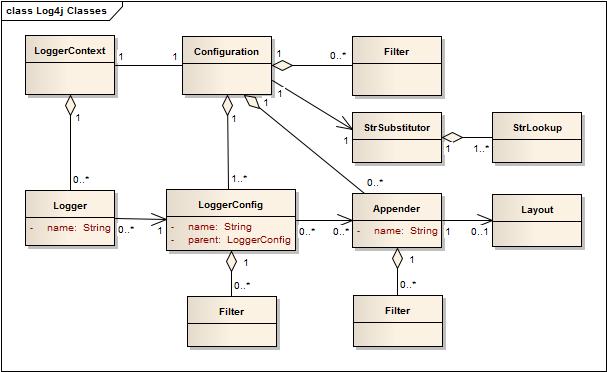Log4j2 Tutorial
1. Log4j2 overview
1.1 Why log?
Logging is an important component of the development cycle.
- provides precise context about a run of the application
- once inserted into code, the generation of logging output requires no human intervention
- moreover, log output can be saved in persistent medium to be studied at a later time
1.2 Why Log4j2?
- Designed to be usable as an audit logging framework , will not lose events while reconfiguring
- Contains asynchrounous loggers, which is 10 times faster than log4j 1.x and logback
- Garbage free for stand alone applications
- Use a plugin system that makes it easy to extend the framework by adding new appenders, filters, layouts, lookups, and pattern converters
- Support for custom log levels
1.3 Log4j Architecture

Applications using the Log4j 2 API will request a Logger with a specific name from the LogManager. The LogManager will locate the appropriate LoggerContext and then obtain the Logger from it. If the Logger must be created it will be associated with the LoggerConfig that contains either a) the same name as the Logger, b) the name of a parent package, or c) the root LoggerConfig. LoggerConfig objects are created from Logger declarations in the configuration. The LoggerConfig is associated with the Appenders that actually deliver the LogEvents.
- Filter
- apply in different time point
- before control is passed to any loggerConfig
- after control is passed to a LoggerConfig but before calling any Appenders
- after control is passed to a LoggerConfig but before calling a specific Appender
- on each Appender
- apply in different time point
- Appender
- selectively enable or disable logging requests
- allow logging requests to print to multiple destinations
- Layout
- Used to customize the output format
- Associate a layout with an appender
2. Migration from Log4j to Log4j2
We usually use log4j/ log4j2 with Slf4j, Slf4j is kind of like a connecter, you could use slf4j as logging system, and slf4j could help you connect to logging framework you want to use: like logback, log4j2, commons-logging, etc.
https://logging.apache.org/log4j/2.x/manual/migration.html
Look at sample 1 in above link for how to set up basic configuration
For some tips:
- The main package in version 1 is org.apache.log4j, in version 2 it is org.apache.logging.log4j
- Calls to org.apache.log4j.Logger.getLogger() must be modified to org.apache.logging.log4j.LogManager.getLogger().
- Calls to org.apache.log4j.Logger.getRootLogger() or org.apache.log4j.LogManager.getRootLogger() must be replaced with org.apache.logging.log4j.LogManager.getRootLogger().
- Calls to org.apache.log4j.Logger.getLogger that accept a LoggerFactory must remove the org.apache.log4j.spi.LoggerFactory and use one of Log4j 2’s other extension mechanisms.
- Replace calls to org.apache.log4j.Logger.getEffectiveLevel() with org.apache.logging.log4j.Logger.getLevel().
- Remove calls to org.apache.log4j.LogManager.shutdown(), they are not needed in version 2 because the Log4j Core now automatically adds a JVM shutdown hook on start up to perform any Core clean ups.
- Starting in Log4j 2.1, you can specify a custom ShutdownCallbackRegistry to override the default JVM shutdown hook strategy.
- Starting in Log4j 2.6, you can now use org.apache.logging.log4j.LogManager.shutdown() to initiate shutdown manually.
- Calls to org.apache.log4j.Logger.setLevel() or similar methods are not supported in the API. Applications should remove these. Equivalent functionality is provided in the Log4j 2 implementation classes, see org.apache.logging.log4j.core.config.Configurator.setLevel(), but may leave the application susceptible to changes in Log4j 2 internals.
- Where appropriate, applications should convert to use parameterized messages instead of String concatenation.
- org.apache.log4j.MDC and org.apache.log4j.NDC have been replaced by the Thread Context.
Reference
转载请注明来源,欢迎对文章中的引用来源进行考证,欢迎指出任何有错误或不够清晰的表达。可以在下面评论区评论,也可以邮件至 stone2paul@gmail.com
文章标题:Log4j2 Tutorial
文章字数:619
本文作者:Leilei Chen
发布时间:2020-04-02, 13:27:56
最后更新:2020-04-02, 13:32:48
原始链接:https://www.llchen60.com/Log4j2-Tutorial/版权声明: "署名-非商用-相同方式共享 4.0" 转载请保留原文链接及作者。

